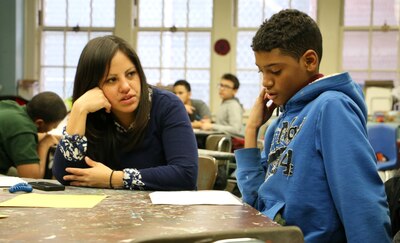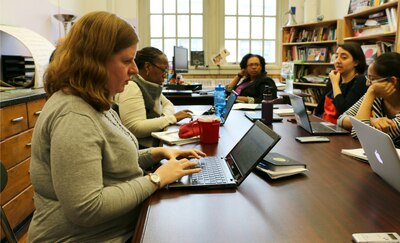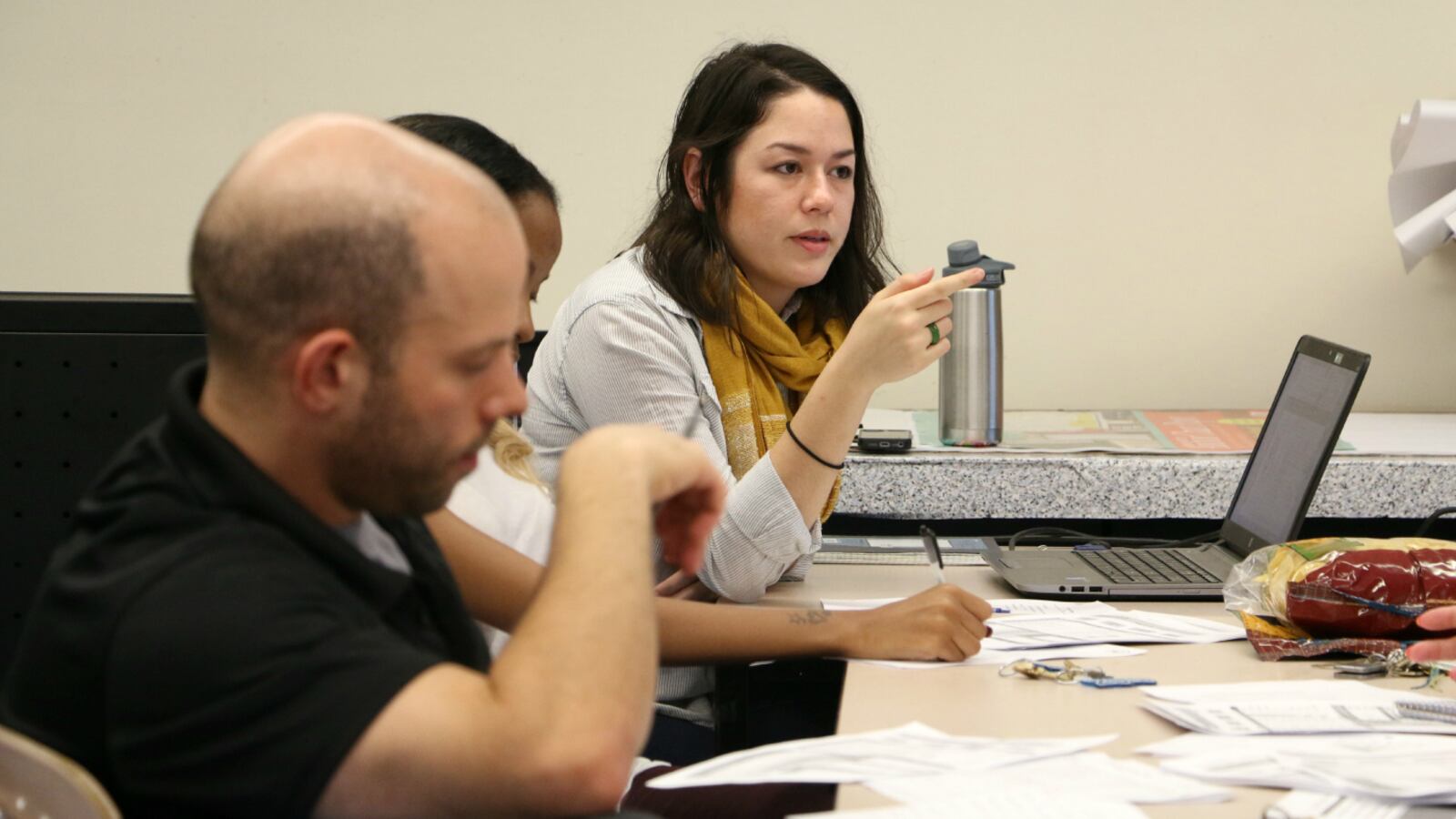At some of the city’s 130 new “community schools,” new assistant principals seemed to have magically appeared and started sitting in on meetings, popping into classrooms, and hastening down hallways.
At the Green School in Williamsburg, Brooklyn, there is Toby Levine, who led a meeting this month where staffers discussed why certain students were missing class — an injured foot, a late shift at work — and how they should intervene.
Nearby at the Juan Morel Campos Secondary School, Katie Hahn and her staff have helped mediate disputes between students and their families and trained teachers on how to work with traumatized youth.
And at M.S. 50 in Brooklyn, Fiorella Guevara has launched a program that replaces traditional parent-teacher conferences with workshops for parents who are still learning English, while also overseeing the school’s mentorship and after-school programs.
Yet these seeming administrators are not assistant principals at all, but former teachers, nurses, social workers, and others who have assumed a remarkable level of authority at some schools — despite the fact that they work for nonprofits, not the city. Known as community school directors, they are on the front lines of a paradigm shift at these schools.
As certain principals offer them significant leadership roles, the directors are helping blur the line between nonprofit and school, putting a central theory of Mayor Bill de Blasio’s school-improvement initiative to the test: That schools must fully integrate outside groups in order to meet students’ academic and personal needs. It’s a novel arrangement for schools and community-based organizations alike, which have often collaborated on programs or projects, but have rarely joined forces as full partners.
“They’ve been in these silos for so long,” said Megan Hester, an organizer at the Annenberg Institute for School Reform who works closely with many community schools, “and now it’s like, Go get married!”

The community school program started in 2014 with 45 schools that struggled with low attendance, then expanded to include 85 low-performing schools. Each school (or, in some cases, multiple schools in the same building) chose a community-based organization, which worked with the principal to hire a full-time community school director.
The director’s job is to help the school identify its greatest needs — counseling services for students with turbulent home lives? Arts classes to inspire hard-to-reach teenagers? — then hire staffers or bring in other nonprofits to meet those needs. But when paired with receptive principals, ambitious directors have managed to push the boundaries of their role, using their six-figure budgets to plug school funding gaps, helping direct school employees in addition to their own, and serving as key advisors to their principals.
M.S. 50 Principal Benjamin Honoroff relies on Guevara, a former teacher and community organizer, to manage initiatives around attendance, arts education, and family outreach. But he also seeks her input on school policy: He heeded her advice to consult the parent-association president when setting the school’s cell phone policy, and he asked her to take a final look at the school’s high-stakes self-assessment.
“I view her as a co-leader of my school,” he said. “We’re texting each other at all hours of the night and sending emails — it’s that kind of relationship.”
Many directors have been notably successful at getting schools to dig deeper into student data.
The city provided the schools with a new online tool that allows them to quickly review students’ academic and attendance records. After signing confidentiality agreements, the directors were given access to that database. Now, many are helping their schools use the system to flag struggling students and coordinate tutoring, counseling, or home visits.
“It’s not something that, frankly, I would use a lot if I didn’t have Paul showing up for this [attendance] meeting every week,” said Patrick Kelly, principal of Urban Science Academy in the Bronx, about his community school director, Paul Neenos.
Other directors have shifted how school staffers interact with students.

Many are spearheading mentorship programs that pair teachers, guidance counselors, and even secretaries with students who are floundering. In many cases, the directors train the school employees on effective ways to check in with students, set goals, and motivate them.
“In its best form,” said Hahn, the director at Campos Secondary School, the community school approach is “a way to build capacity in a school, so it’s not about an outside agency just coming in and plugging in its services.”
In schools where the initiative has taken hold, principals have come to rely on the directors to do much more than run an after-school program or hire counselors.
For instance, Neenos and the nonprofit he works for, Center for Supportive Schools, are helping Urban Science Academy and two other schools in its building develop better ways for teachers to plan lessons together. Neenos also helps the principals prepare the presentations they must give to education department officials showing how they have used data to tackle school challenges.
Toby Levine meets individually with Green School Principal Cara Tait for two hours each week, where they troubleshoot school trends (for example, sagging attendance on field trip days) and plan for the future, like how to welcome next year’s ninth-graders. Levine even dipped into her budget to pay for an instructional coach that the school couldn’t afford.
“These are things I had as ideas,” Tait said, “but I didn’t always have the capacity to bring to fruition.”
Still, some marriages work better than others.
Some of the most effective directors had previously worked in both schools and nonprofits, but others without that background have had to learn more on the job. And while some of the 46 partner organizations that supervise the directors had prior experience managing schools, others had not.
(The groups also vary widely in how much they pay directors. Because the nonprofits have different pay scales, directors’ salaries range from about $40,000 to $90,000 or more even though their responsibilities are largely the same.)
Meanwhile, some principals are more eager than others to delegate duties and make joint decisions with their directors and community-based organizations.
“There are some schools where the principals do seem to have bought into the CBO partnership” and view their directors as a “chief of staff or a right-hand person,” said Emma Hulse, lead organizer for the New Settlement Parent Action Committee, which works with many community schools in the South Bronx. “There are other schools where the principals are like, I didn’t want this person here, and they’re going to push back on everything the CBO says.”
Chris Caruso, executive director of the education department’s community schools office, said that schools had not had a problem finding highly qualified directors, and that all but four of the director positions are currently filled. The nonprofits have enough funding in their contracts to pay the directors’ competitive salaries, he added, which is considered $84,000 on average for a director with a master’s degree.
The city provides monthly trainings to the directors, and Caruso and his 17-person team regularly visit the schools to offer coaching and support. In cases where the partnerships are not running smoothly, his office will intervene and can replace the nonprofit or director — which Caruso said has already happened in a couple cases.
“This is a change in mindset on everyone’s front,” he said. “We’re asking a lot of school leaders, and CBOs, and communities to think differently about these schools.”
“But,” he added, “the vast majority of these relationships have been overwhelmingly positive.”

